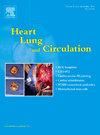新西兰植入式心律转复除颤器受者的长期临床结果和死亡率预测因素(ANZACS-QI 83)。
IF 2.2
4区 医学
Q2 CARDIAC & CARDIOVASCULAR SYSTEMS
引用次数: 0
摘要
背景:新西兰植入式心脏转复除颤器(ICD)受者的长期临床结果尚不清楚。本研究旨在比较新西兰一级和二级预防ICD受者的全因死亡率,并确定死亡率的预测因素。方法:2016年至2020年期间在新西兰接受一级或二级预防ICD的患者使用Aotearoa新西兰所有心脏病学服务质量改进心脏植入设备登记处[ANZACS-QI Device]进行识别,该登记处是心脏植入电子设备的国家登记处。排除有浸润性心肌病、先天性心脏病和血管病变的患者。主要结局为全因死亡率。次要结局是心血管(CVD)死亡率、非CVD死亡率、心力衰竭住院和室性心律失常住院。报告Kaplan-Meier曲线的Log-rank检验和4年Kaplan-Meier事件发生率。采用Cox回归多因素分析确定全因死亡率的预测因素。结果:1990例患者,其中一级预防1067例(53.6%),二级预防923例(46.4%),平均随访4.0±1.5年。年龄中位数为62岁,29.6%为Māori或太平洋岛民。4年时,一级预防组的全因死亡率高于二级预防组(17.1% vs 11.8%;p = 0.002)。这是由于心血管疾病死亡率较高(11.9% vs 7.3%;p=0.008),非心血管疾病死亡率无显著差异(5.9% vs 4.8%;p = 0.093)。与二级预防组相比,一级预防组有更多的心力衰竭住院(30.2% vs 17.9%;p2降低:一级预防HR 1.21;结论:在新西兰ICD受术者中,一级预防的长期全因死亡率和心血管疾病死亡率高于二级预防ICD植入者。两组患者的非心血管疾病死亡率都很低且相似,这与适当的患者选择一致。Māori和太平洋岛民患者观察到的较高死亡率需要进一步调查。本文章由计算机程序翻译,如有差异,请以英文原文为准。
Long-Term Clinical Outcomes and Predictors of Mortality in Implantable Cardioverter-Defibrillator Recipients in New Zealand (ANZACS-QI 83)
Background
The long-term clinical outcomes of implantable cardioverter-defibrillator (ICD) recipients across New Zealand are unknown. This study aims to compare the all-cause mortality of primary and secondary prevention ICD recipients in New Zealand and identify predictors of mortality.
Method
Patients who received a primary or secondary prevention ICD in New Zealand between 2016 and 2020 were identified using the Aotearoa NZ All Cardiology Services Quality Improvement Cardiac Implanted Device Registry [ANZACS-QI DEVICE], a national registry for cardiac implantable electronic devices. Patients with infiltrative cardiomyopathies, congenital heart disease, and channelopathies were excluded. The primary outcome was all-cause mortality. Secondary outcomes were cardiovascular (CVD) mortality, non-CVD mortality, heart failure hospitalisation, and ventricular arrhythmia hospitalisation. Log-rank tests on Kaplan–Meier curves and 4-year Kaplan–Meier event rates were reported. Cox regression multivariate analysis was performed to identify predictors of all-cause mortality.
Results
There were 1,990 patients, including 1,067 (53.6%) primary prevention and 923 (46.4%) secondary prevention ICD recipients, with a mean follow-up of 4.0±1.5 years. The median age was 62 years, 29.6% were Māori or Pacific Islanders.
At 4 years, the all-cause mortality was higher in the primary prevention group than in the secondary prevention group (17.1% vs 11.8%; p=0.002). This was due to a higher rate of CVD mortality (11.9% vs 7.3%; p=0.008), with no significant difference in non-CVD mortality (5.9% vs 4.8%; p=0.093). Compared with the secondary prevention group, the primary prevention group had more heart failure hospitalisations (30.2% vs 17.9%; p<0.001) but fewer ventricular arrhythmia hospitalisations (14.8% vs 29.0%; p<0.001).
Significant predictors of mortality in multivariate regression analyses were Māori or Pacific Islander ethnicity (primary prevention hazard ratio [HR] 2.12; p<0.001; secondary prevention HR 1.71; p=0.018); older age (per 10-year increase in age: primary prevention HR 1.33; p=0.003; secondary prevention HR 1.72; p<0.001), and poorer renal function (per 10 mL/min/1.73m2 decrease: primary prevention HR 1.21; p<0.001; secondary prevention HR 1.25; p<0.001). Previous myocardial infarction was not a significant predictor of mortality in either cohort.
Conclusions
In New Zealand ICD recipients, long-term all-cause mortality and CVD mortality rates were higher in primary prevention than secondary prevention ICD implants. Non-CVD mortality was low and similar in both cohorts, consistent with appropriate patient selection. The higher mortality observed for Māori and Pacific Islander patients require further investigation.
求助全文
通过发布文献求助,成功后即可免费获取论文全文。
去求助
来源期刊

Heart, Lung and Circulation
CARDIAC & CARDIOVASCULAR SYSTEMS-
CiteScore
4.50
自引率
3.80%
发文量
912
审稿时长
11.9 weeks
期刊介绍:
Heart, Lung and Circulation publishes articles integrating clinical and research activities in the fields of basic cardiovascular science, clinical cardiology and cardiac surgery, with a focus on emerging issues in cardiovascular disease. The journal promotes multidisciplinary dialogue between cardiologists, cardiothoracic surgeons, cardio-pulmonary physicians and cardiovascular scientists.
 求助内容:
求助内容: 应助结果提醒方式:
应助结果提醒方式:


